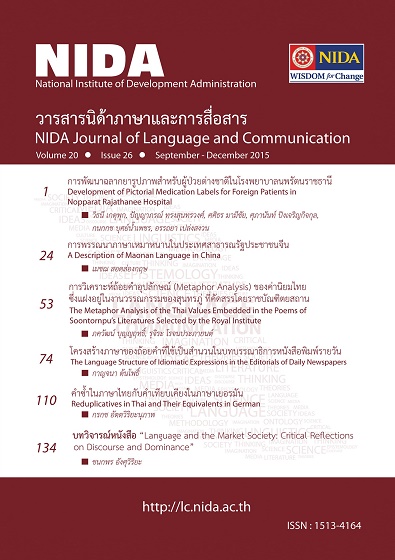DEVELOPMENT OF PICTORIAL MEDICATION LABELS FOR FOREIGN PATIENTS IN NOPPARAT RAJATHANEE HOSPITAL
Keywords:
pictorial medication labels, foreign patientsAbstract
Aim of this research is to develop pictorial medication labels for conveying medical instructions to foreign patients and to evaluate understanding of medical administration from the pictorial labels. Data were collected by interview 402 foreign patients and their relatives at Nopparatrajathanee Hospital during April to June 2014. The study was divided in two phases i.e. the development of instruments and assessing of pictorial labels understanding. There were 9 pictorial labels: 1/4 tablet after breakfast once a day, ½ tablet after breakfast once a day, 2 tablets twice daily after breakfast and dinner, 1 tablet twice daily before breakfast and dinner, 1 tablet 3 times a day after breakfast-lunch-dinner, 1 tablet 3 times a day before breakfast-lunch-dinner, 1 tablet 4 times a day after breakfast-lunch-dinner and at bed time, 1 tablet 4 times a day before breakfast-lunch-dinner and at bed time, and 2 tablets at bedtime once daily.
As result of random sampling with more females than males (77.86% and 22.14%), the study found that more than half of them are 21-30 years old (56.00%). Most of them work as employee (84.00%) and 42.30% has been in Thailand for 1-5 years, 69.40% lives with Thai people. The study was found that the ninth pictorial label (2 tablets at bedtime once daily) was the most correct answers in every parts (73.4%), similar to the fifth pictorial label (1 tablet 3 times a day after breakfast-lunch-dinner) which was 72.9%.
However, once considering each parts of all pictorial labels, number of time to take medicine (once a day, twice a day, 3 times a day, and 4 times a day) was the most correct answer (85.96% on average) following by number of tablet to take in each time (84.82% on average) and time to take medicine (morning, noon, evening, and bedtime) was 80.82% on average. Time to take medicine related to meals (before or after meal) was the least correct answers (68.56% on average).
In summary, these developed pictorial labels were not accomplished in accordance with ANSI so improvement might be needed. Nevertheless, these labels may be useful for medical instructions communication with patients, together with verbal explanation, non-verbal explanation and/or medical samples. This will help the patients to recall meaning when they see these pictorial labels of their medical administration.
Downloads
How to Cite
Issue
Section
License
By submitting a manuscript, the author transfers the copyright for the article to School of Language and Communication, National Institute of Development Administration (NIDA), if and when the manuscript is accepted for publication. Though the journal is an open-access, reproduction of any material published in NIDA Journal of Language and Communication for non-personal and/or commercial purpose requires a written permission from School of Language and Communication, National Institute of Development Administration (NIDA).






